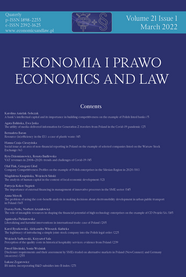VAT revenues in 2008–2020: trends and challenges of Covid-19
VAT revenues in 2008–2020: trends and challenges of Covid-19
Author(s): Ryta Dziemianowicz, Renata BudlewskaSubject(s): Economic policy, Government/Political systems, Health and medicine and law, Transformation Period (1990 - 2010), Present Times (2010 - today), Fiscal Politics / Budgeting
Published by: Wydawnictwo Naukowe Uniwersytetu Mikołaja Kopernika
Keywords: tax policy; tax revenues; tax expenditures; VAT; Covid-19;
Summary/Abstract: Motivation: VAT revenues are particularly vulnerable to economic turbulence, especially if the crisis directly affects private consumption or changes its structure. Even when consumption levels are relatively high, VAT revenues may be lower due to a shift in consumer spending to the most essential goods or services or an increase in public sector consumption. Because of the reduction in operation and the closure of many businesses, the Covid-19 crisis is likely to have an even greater impact on consumption than the previous financial crisis of 2008. Aim: The purpose of this article is to analyse VAT revenues in OECD countries over the period 2008–2020, identify general trends, and highlight similarities and differences in this regard between the 2008 financial crisis and the Covid-19 crisis. Results: Consumption taxes account for about 33% of all taxes collected in OECD countries, of which 20% is VAT. Covid-19 could change that in an important manner. After the 2008 global financial crisis, tax revenues, including VAT, returned to pre-crisis levels after an average of eight years. VAT revenues in relation to GDP peaked in 2016, and have been stable since then. Due to reduced operation and closure of businesses, the Covid-19 epidemic not only changed the structure of private consumption, but also significantly affected its level. In addition, government actions reducing certain rates have contributed to the decline in VAT revenues. As the survey results indicate, standard VAT rates between 2017 and 2020 were at record high levels, averaging 19.3%. With such high rates, in order to re-store VAT revenues after the crisis, governments may have to think about how to broaden the tax base (e.g., temporarily lower rates and stimulate consumption)
Journal: Ekonomia i Prawo. Economics and Law
- Issue Year: 21/2022
- Issue No: 1
- Page Range: 85-102
- Page Count: 18
- Language: English

